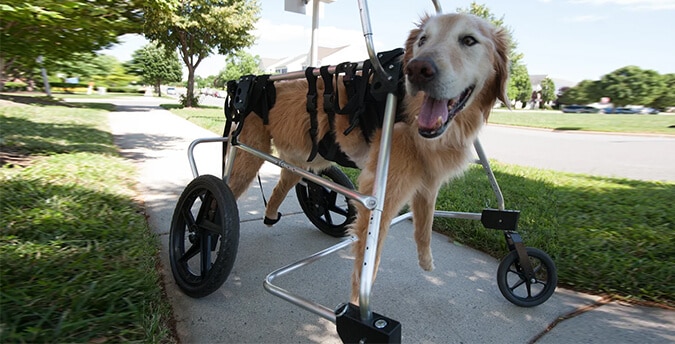What is Degenerative Myelopathy & What Breeds are at Risk?

Degenerative Myelopathy (DM) is a spinal cord disorder that affects adult dogs and that is similar to Lou Gehrig’s disease in people. DM degrades the “white matter” surrounding the spinal cord and affects the peripheral nervous system.
This “white matter” forms the nervous system superhighway that transmits movement commands from the brain to the body while sending sensory information to the brain. The disease most commonly affects the Rhodesian Ridgeback, German Shepherds, Boxers, Corgis, Chesapeake Bay Retrievers, and Poodles. However, other breeds and mixed-breed dogs are also at risk of developing the disorder.
The onset of DM typically begins in the late adult to early senior years in dogs, with both male and females equally affected by the condition. DM is a genetic disorder inherited from the parents of the breeding stock. If both parents suffer from DM, then there’s an 85-percent chance that all puppies in their litters will experience the onset of DM in later life.
DM is not a painful disease and does not affect the pain centers in the brain. However, movements that compensate for weakness in the rear legs may induce pain in the shoulders and elbows of the affected dog.
SYMPTOMS OF DEGENERATIVE MYELOPATHY IN DOGS
DM is a terrible condition that slowly eats away at the nervous system, and it’s saddening to watch your beloved pet lose their mobility. The first symptoms of the disorder are a loss in the coordination of movement in the hind legs. As DM progresses, your dog may drag the knuckles of their hind feet and be unaware that they’re doing so. This dragging leads to the scraping of the skin and bleeding.
Your dog may find it challenging to walk up stairs or jump into the car. Therefore, they tend to avoid these sorts of activities that involve strength coming from the hind legs. As the condition progresses, the front legs become weak and may buckle during walking or standing. Eventually, your pup loses the ability to walk on the hind legs and requires the assistance of a dog wheelchair to remain mobile.
The advanced stages of DM include fecal and urinary incontinence, as well as a loss in mobility of the front limbs. Without intervention or treatment, the dog becomes paralyzed in the rear end in as little as six months to a year.
DIAGNOSIS OF DEGENERATIVE MYELOPATHY
If you suspect your dog is suffering from DM, take them to the vet for diagnosis. Your vet uses a process of elimination to diagnose the disorder. The vet will look for signs of more common diseases or disorders before diagnosing DM. Other health issues that present similar symptoms to DM include hip dysplasia and herniated invertebral disc.
TREATING DEGENERATIVE MYELOPATHY
DM is a chronic disorder that has no cure. Treatment won’t clear your dog of DM, but it can slow the progression of the condition and help your dog enjoy a higher quality of life in their senior years. It’s essential to use a canine physiotherapist to assist your dog in their physical rehabilitation.
There’s a fine line between doing enough exercise to improve mobility, and over-doing the rehabilitation. Doing too much rehab work is worse for your dog than doing nothing at all. A typical therapy program includes walking, stretching, and medication to manage pain symptoms associated with the therapy.
There are various preventative measures you can take to assist your dog as the disorder advances. Buy them a pair of booties for their hind legs to minimize any damage from dragging their feet. When the condition takes away the mobility of their hindquarters, consider buying them a dog wheelchair or support harness.
Make sure you’re feeding your dog a good-quality food and supplement their diet with joint-protecting formulas that include glucosamine, calcium, and chondroitin.
